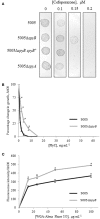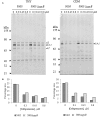SpyB, a Small Heme-Binding Protein, Affects the Composition of the Cell Wall in Streptococcus pyogenes
- PMID: 27790410
- PMCID: PMC5061733
- DOI: 10.3389/fcimb.2016.00126
SpyB, a Small Heme-Binding Protein, Affects the Composition of the Cell Wall in Streptococcus pyogenes
Abstract
Streptococcus pyogenes (Group A Streptococcus or GAS) is a hemolytic human pathogen associated with a wide variety of infections ranging from minor skin and throat infections to life-threatening invasive diseases. The cell wall of GAS consists of peptidoglycan sacculus decorated with a carbohydrate comprising a polyrhamnose backbone with immunodominant N-acetylglucosamine side-chains. All GAS genomes contain the spyBA operon, which encodes a 35-amino-acid membrane protein SpyB, and a membrane-bound C3-like ADP-ribosyltransferase SpyA. In this study, we addressed the function of SpyB in GAS. Phenotypic analysis of a spyB deletion mutant revealed increased bacterial aggregation, and reduced sensitivity to β-lactams of the cephalosporin class and peptidoglycan hydrolase PlyC. Glycosyl composition analysis of cell wall isolated from the spyB mutant suggested an altered carbohydrate structure compared with the wild-type strain. Furthermore, we found that SpyB associates with heme and protoporphyrin IX. Heme binding induces SpyB dimerization, which involves disulfide bond formation between the subunits. Thus, our data suggest the possibility that SpyB activity is regulated by heme.
Keywords: ADP-ribosyltransferase; Group A carbohydrate; SpyA; SpyB; Streptococcus pyogenes; cell wall; heme.
Figures







Similar articles
-
SpyA is a membrane-bound ADP-ribosyltransferase of Streptococcus pyogenes which modifies a streptococcal peptide, SpyB.Mol Microbiol. 2012 Mar;83(5):936-52. doi: 10.1111/j.1365-2958.2012.07979.x. Epub 2012 Jan 30. Mol Microbiol. 2012. PMID: 22288436 Free PMC article.
-
Identification and characterization of HtsA, a second heme-binding protein made by Streptococcus pyogenes.Infect Immun. 2003 Oct;71(10):5962-9. doi: 10.1128/IAI.71.10.5962-5969.2003. Infect Immun. 2003. PMID: 14500516 Free PMC article.
-
Molecular basis for recognition of the Group A Carbohydrate backbone by the PlyC streptococcal bacteriophage endolysin.Biochem J. 2021 Jun 25;478(12):2385-2397. doi: 10.1042/BCJ20210158. Biochem J. 2021. PMID: 34096588 Free PMC article.
-
The surface protein Shr of Streptococcus pyogenes binds heme and transfers it to the streptococcal heme-binding protein Shp.BMC Microbiol. 2008 Jan 23;8:15. doi: 10.1186/1471-2180-8-15. BMC Microbiol. 2008. PMID: 18215300 Free PMC article.
-
A review of penicillin binding protein and group A Streptococcus with reduced-β-lactam susceptibility.Front Cell Infect Microbiol. 2023 Mar 31;13:1117160. doi: 10.3389/fcimb.2023.1117160. eCollection 2023. Front Cell Infect Microbiol. 2023. PMID: 37065204 Free PMC article. Review.
Cited by
-
Artemisinin-resistant Plasmodium falciparum Kelch13 mutant proteins display reduced heme-binding affinity and decreased artemisinin activation.Commun Biol. 2024 Nov 13;7(1):1499. doi: 10.1038/s42003-024-07178-2. Commun Biol. 2024. PMID: 39538019 Free PMC article.
-
Genome sequence analysis of emm89 Streptococcus pyogenes strains causing infections in Scotland, 2010-2016.J Med Microbiol. 2017 Dec;66(12):1765-1773. doi: 10.1099/jmm.0.000622. Epub 2017 Nov 3. J Med Microbiol. 2017. PMID: 29099690 Free PMC article.
-
Heme Binding to HupZ with a C-Terminal Tag from Group A Streptococcus.Molecules. 2021 Jan 21;26(3):549. doi: 10.3390/molecules26030549. Molecules. 2021. PMID: 33494451 Free PMC article.
-
An In-Silico Sequence-Structure-Function Analysis of the N-Terminal Lobe in CT Group Bacterial ADP-Ribosyltransferase Toxins.Toxins (Basel). 2019 Jun 21;11(6):365. doi: 10.3390/toxins11060365. Toxins (Basel). 2019. PMID: 31234283 Free PMC article.
-
The molecular mechanism of N-acetylglucosamine side-chain attachment to the Lancefield group A carbohydrate in Streptococcus pyogenes.J Biol Chem. 2017 Nov 24;292(47):19441-19457. doi: 10.1074/jbc.M117.815910. Epub 2017 Oct 11. J Biol Chem. 2017. PMID: 29021255 Free PMC article.
References
-
- Ascoli F., Fanelli M. R., Antonini E. (1980). Preparation and properties of apohemoglobin and reconstituted hemoglobins. Methods Enzymol. 76, 72–87. - PubMed
MeSH terms
Substances
Grants and funding
LinkOut - more resources
Full Text Sources
Other Literature Sources
Miscellaneous

